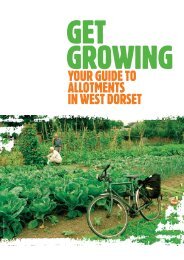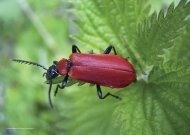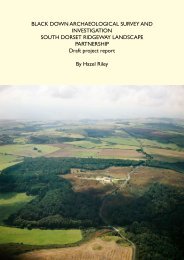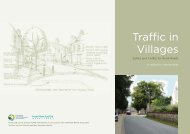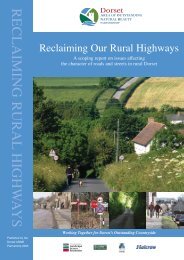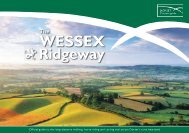Woodland Strategy 11.34 Mb - the Dorset AONB
Woodland Strategy 11.34 Mb - the Dorset AONB
Woodland Strategy 11.34 Mb - the Dorset AONB
Create successful ePaper yourself
Turn your PDF publications into a flip-book with our unique Google optimized e-Paper software.
Section 3<br />
Oak 13.3%<br />
<strong>Woodland</strong> Area by Principal Species<br />
(excluding coppice, felled and open areas)<br />
Beech 9.5%<br />
Sycamore 3.5%<br />
Ash 12.2%<br />
Birch 5.6%<br />
condition and biodiversity. However <strong>the</strong> county still retains a good number of important<br />
sites sixty five woodland and parkland areas included within Sites of Special Scientific Interest<br />
(SSSI), although specific woodland SSSIs are under-represented in <strong>Dorset</strong> (M Heath, pers<br />
comm.) Two of <strong>the</strong>se areas are designated as Special Areas of Conservation (SACs). In<br />
addition <strong>the</strong>re are 621 woodland Sites of Nature Conservation Interest (SNCIs). All comprise<br />
6,693 hectares. In recent years more innovative silviculture practises have been adopted,<br />
such as Continuous Cover Forestry (CCF) and <strong>the</strong>re has been a resurgence of coppicing.<br />
Much of <strong>the</strong> ancient woodland cover is to be found on <strong>the</strong> clay and alluvial soils in <strong>the</strong><br />
county although <strong>the</strong>re are a number of scattered woodlands on chalk soils. The more recent<br />
forestry conifer plantings are predominantly on <strong>the</strong> drier, sandier soils to <strong>the</strong> sou<strong>the</strong>ast of<br />
<strong>the</strong> county, whilst broadleaf plantations have been established on chalk soils.<br />
21<br />
Mixed<br />
Conifer 0.9%<br />
O<strong>the</strong>r<br />
Conifer 12.3%<br />
Larch 2.4%<br />
Elm 0.1%<br />
O<strong>the</strong>r<br />
Broadleaves 8.1%<br />
Mixed<br />
Broadleaves 8.3%<br />
Between 1995 and 2005 over 2,190 hectares were planted with trees in <strong>Dorset</strong>, with over<br />
1000 hectares being ‘new’ woodland planting, a significant increase of approximately 4%<br />
of woodland cover over <strong>the</strong> county.<br />
Pine 23.8%<br />
<strong>Dorset</strong>’s woodland cover has probably remained relatively constant since about 4,000 years<br />
ago. Few woodlands remain that are managed sustainably and <strong>the</strong>se only account for a small<br />
proportion of <strong>the</strong> total resource. Very few parklands or wooded commons were managed<br />
through history, some lasting no more than decades before going into decline. Those that<br />
did survive up to <strong>the</strong> World War 2 have since been grubbed out, or neglected. The few<br />
remaining managed parklands, such as Melbury Park, Charborough Park and Stock Gaylard<br />
give an indication of how things were. Those woodlands and parklands that remain in a<br />
well-managed condition are extremely important in <strong>the</strong>ir own right and <strong>the</strong> county is<br />
nationally recognised for its number and quality of woodland and veteran trees species.<br />
Quality UK grown timber © Forestry Commission<br />
In reality traditional woodland management has been in decline since <strong>the</strong> end of <strong>the</strong><br />
19th century, and in many woodlands <strong>the</strong> lack of appropriate management and impact of<br />
agricultural and forestry policies has been a major factor in <strong>the</strong> loss of habitat composition,



